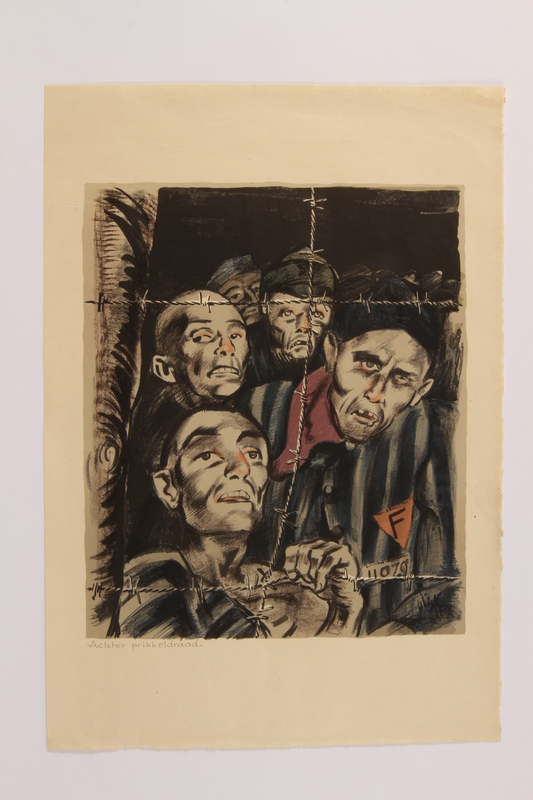Overview
- Brief Narrative
- Color offset lithographic reproduction of a drawing, Ackter prikkeldraad [Behind barbed Wire] by Henri Pieck depicting prisoners in Buchenwald concentration camp in Germany in 1945.
- Artwork Title
- Ackter prikkeldraad
- Title
- Henri Pieck: 7 Origineele Kleurenlitho's Van Beelden Uit Het Concentratiekamp Buchenwald
- Date
-
publication/distribution:
1945
- Geography
-
publication:
Hague (Netherlands)
depiction: Buchenwald (Concentration camp); Weimar (Thuringia, Germany)
- Credit Line
- United States Holocaust Memorial Museum Collection, Gift of Rose Galek Brunswic
- Contributor
-
Artist:
Henri Pieck
Publisher: Uitgeverij Het Centrum
- Biography
-
Henri Christiaan Pieck was born on April 19, 1895, in Den Helder, Netherlands. He had a twin brother Anton. Both brothers would have successful careers as artists. Henri’s talent was recognized early, and he began drawings lessons while a young boy. In 1912, he moved to Amsterdam where he joined the Communist Party in 1914. Pieck became a painter, with a special interest in portraits of dancers and scenes of working class life. He was also a commercial artist and illustrator. By 1920, he was receiving major commissions, such as a series of paintings for the Scala Theater in The Hague. Pieck married Geziena van Gelder in July 1922 and they had a son. The couple divorced in May 1928, and later that month, Pieck married Bernharda van Lier in England. They had two daughters. He divided his time between Geneva, London, and Paris and sometimes worked as a courier for the Dutch Foreign Ministry. By the 1930s, Pieck and his second wife Bernharda were spies for the Soviet Union. His Soviet handler was Ignacs Reiss. Pieck cultivated several contacts in the British Foreign Service, who provided him with code books, correspondence, and other official documents.
In May 1940, Germany occupied the Netherlands. They installed a civil administration under the control of the SS, staffed chiefly by German and Austrian born Nazis. Pieck was a member of the Communist underground and helped produce the journal De Vonk. He was arrested by the Germans on June 9, 1941, for resistance activities. He was interned in Scheveningen prison and the German police transit camp Amersfoort. In April 1942, Pieck was deported to Buchenwald concentration camp in Germany. His artistic talent gave him some protection in the camp and he did portraits and other drawings and paintings for the SS guards. Pieck was part of the Dutch section of the International Camp Committee, and they provided him with materials to record the atrocities and dreadful conditions in the camp.
In early April 1945, as the Allies approached, the Germans began to evacuate the camp. On April 11, the prisoners seized control of the camp, and later that afternoon, US troops entered Buchenwald. Germany surrendered on May 7, 1945. Pieck was repatriated to the Netherlands. In 1945-46, a portfolio of the drawings he made in Buchenwald were published. He created drawings of the devastation caused by the war the Netherlands which were also published in the immediate postwar period. He had a postwar career as a commercial artist and designer. Pieck, age 77, died in The Hague on January 12, 1972.
Physical Details
- Language
- Dutch
- Classification
-
Art
- Category
-
Prints
- Object Type
-
Prints (lcsh)
- Physical Description
- 45 cm.
t.p. ; 7 color lithograph plates (plates: 12.00 x 17.125 inches (44 x 31 centimeters)
Offset color lithograph depicting a crowd of prisoners gathered at a barbed wire fence. In the foreground are the faces of four, individualized skeletal inmates with desperate expressions. The man in front clutches the barbed wire. The man on the right has a red scarf and a red inverted triangle patch with the letter F, which designates a French prisoner, above a number patch, 11079. The artist's signature, HPieck 45, is reproduced in the right corner of the plate. The title caption is below the image on the left.
Rights & Restrictions
- Conditions on Access
- No restrictions on access
- Conditions on Use
- No restrictions on use
Keywords & Subjects
Administrative Notes
- Legal Status
- Permanent Collection
- Provenance
- The folio was donated to the United States Holocaust Memorial Museum in 2006 by Rose Galek Brunswic.
- Funding Note
- The cataloging of this artifact has been supported by a grant from the Conference on Jewish Material Claims Against Germany.
- Record last modified:
- 2023-05-26 10:12:44
- This page:
- https://collections.ushmm.org/search/catalog/irn33116
Also in Henri Pieck collection
The collection consists of a published folio inscribed by the artist, Henri Pieck: 7 Origineele Kleurenlitho's Van Beelden Uit Het Concentratiekamp Buchenwald, seven reproductions of sketches of prisoners in Buchenwald concentration camp based on his experiences as an inmate.
Date: 1945
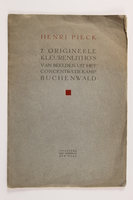
Folio
Object
Cover for a folio of seven offset color lithographs by Henri Pieck depicting prisoners in Buchenwald concentration camp in Germany in 1945.
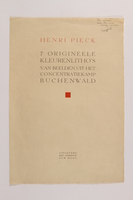
Folio
Object
Title page inscribed by the artist, Henri Pieck, for a folio of seven offset color lithographs depicting prisoners and prison life in Buchenwald concentration camp in Germany in 1945.
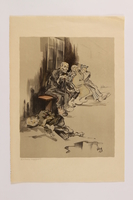
Object
Color offset lithographic reproduction of a drawing, Zieken-rappor [Sick report], by Henri Pieck depicting a prisoner in Buchenwald concentration camp in Germany in 1945.
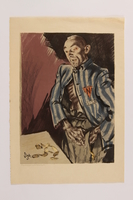
Object
Color offset lithographic reproduction of a drawing, Aardappelschillenbuit [Emptying Potato Peels], by Henri Pieck depicting a prisoner in Buchenwald concentration camp in Germany in 1945.
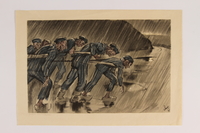
Object
Color offset lithographic reproduction of a drawing, Joden als trekdier [Jews as Draft Animals] by Henri Pieck depicting prisoners in Buchenwald concentration camp in Germany in 1945.
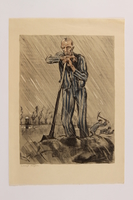
Object
Color offset lithographic reproduction of a drawing, Lange Dagen [Long Days] by Henri Pieck depicting prisoners in Buchenwald concentration camp in Germany in 1945.
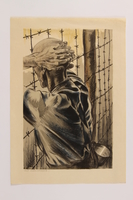
Object
Color offset lithographic reproduction of a drawing, Het onbereikbare [The Unattainable] by Henri Pieck depicting a prisoner in Buchenwald concentration camp in Germany in 1945.
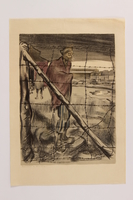
Object
Color offset lithographic reproduction of a drawing, Monsieur le Ministre [Mr. Minister] by Henri Pieck depicting a prisoner in Buchenwald concentration camp in Germany in 1945.

